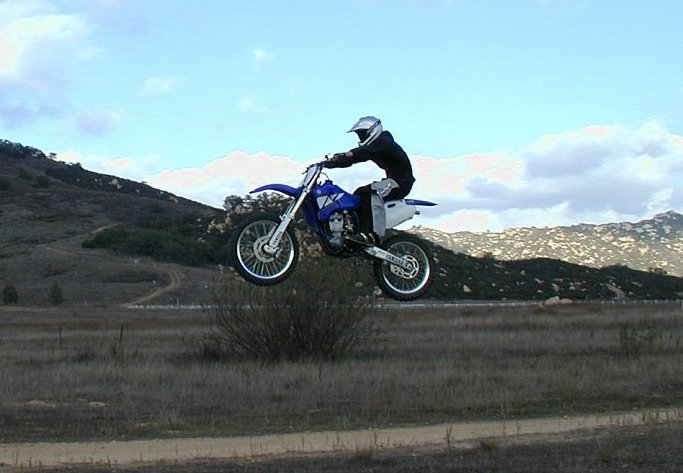
|
Seventeen year old test rider Alex Edge. First five minutes on the bike; third lap on the track;
5th gear pinned; 70 feet to a flat landing … “I really like this bike, Dad. How long do we get to test it?” “Not long enough.” |
We really should apologize to our readers for this review. In fact, you may not want to read this review, if you are interested in buying a new dirt bike this year. Yamaha’s 2001 YZ250F is largely sold out in the United States, with deposits covering many of the bikes yet to be delivered to dealers.
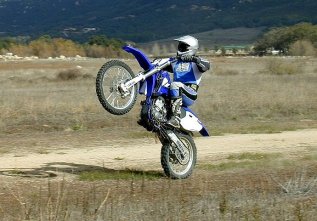 |
|
(Click to enlarge)
|
We’ll get to the bottom line, first. The “Holy Grail” of off-road motorcycling is the ultimate combination of light weight, flickable handling, and engine performance. 125cc two-strokes have the handling off-roaders love, but not quite enough motor for most of them. 250cc motocrossers, and open class four-strokes, have the grunt and horsepower, but they can’t match a 125cc two-stroke in the handling department. The “perfect mix” of handling and power may never be found, but a new benchmark has been created by Yamaha’s 2001 YZ250F.
We only had the YZ250F for a few days of testing (contrary to our expectations). Nevertheless, it doesn’t take long to tell that this bike is something special. Our testers have years of experience on every type of off-road machine, both two-stroke and four-stroke. The 2001 Yamaha YZ250F comes closest to embodying the characteristics of off-roading’s “Grail”.
This bike, in our opinion, handles better than a 125cc two-stroke. It feels almost as light (lighter than a 250cc two-stroke, but not quite as light as a 125) and maneuvers better on the track and trail than a 125cc two-stroke. The added traction from the 250 motor, both while accelerating and decelerating, makes the tires bite in that four-stroke manner that two-strokes simply cannot match.
Cornering on the open class four-strokes is good — in some ways better than the 250cc two-strokes. Cornering is better on a YZ250F than on a 125cc two-stroke for the same reasons. By the way, until now, if you were able to corner better than a 125cc two-stroke pilot, you were on an 80. Whether through berms or flat turns, rutted or smooth, we found the cornering ability of the YZ250F to be superb. Stable and predictable, yet able to take any line available.
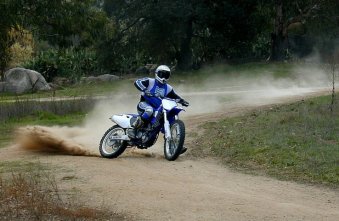 |
|
(Click to enlarge)
|
The second part of this equation is the engine. This is the real shocker. 250cc four-strokes, in the minds of motocrossers everywhere for the past two decades, are slow. Plain and simple. The YZ250F, on the other hand, is fast, tractable, and usable. The tractable and usable parts of this equation are not new, but the fast part is.
The powerband on the YZ250F is far broader than that of a two-stroke 125, and the torque of the YZ250F is far greater than that of a two-stroke 125. Peak horsepower is another matter.
The peak horsepower of the YZ250F is in the same ballpark as a 125cc two-stroke. This isn’t really a bad thing, because the faster 125cc two strokes have plenty of peak horsepower. The difference is, once again, that the YZ250F makes usable horsepower over a far broader rpm range. Take a look at our discussion of the first two dyno charts published for the YZ250F in our article dated December 2, 2000.
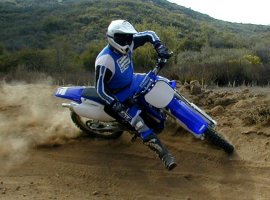 |
|
(Click to enlarge)
|
The handling is typical Yamaha motocrosser — good straight-line stability is mixed with the corner carving ability. We did experience some headshake through whoops, and, in the short time we had the bike, never quite came to grips with the proper suspension settings.
Yamaha forks this year break in slowly. You need to ride your new Yamaha with the stock settings (which will feel harsh) three or four times, pushing the forks through their stroke (even bottoming them, if possible). At that point, they should become reasonably plush. Perhaps, Yamaha needs more time dialing in the suspension on the YZ250F. The two-stroke (either 250 or 125) suspension settings probably aren’t quite right for this bike and, the far heavier YZ426 wouldn’t provide a benchmark, either.
The stock suspension is good enough, however, to make the handling traits of this bike quite clear, and those handling traits are very, very good. We hope to get more time on a YZ250F later, and provide some suspension setting recommendations at that time.
The transmission is good. After you clunk down into first gear, and get moving, the transmission shifts well and disappears from your thoughts. No missed shifts were experienced.
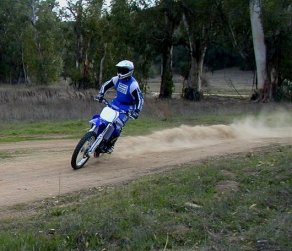 |
|
(Click to enlarge)
|
The YZ250F shares its front braking system with the other YZs this year. This is a good thing, because the new, larger rotor and re-designed master cylinder provide excellent braking. The relatively light weight of the YZ250F is a plus in this regard, as well.
Doug Dubach’s comments in our interview dated June 15, 2000 rang true. The YZ250F is the easiest, least tiring motocross bike we have yet ridden. You will pound out more laps on this bike than you could on any other motocross bike, and come away feeling fresher. This has to do with the power delivery and the engine braking, both of which make your job easier on the track.
We did get more wheel spin while accelerating on this bike than we expected. It still hooks up fairly well (it is a four-stroke, after all), but some further dialing of the rear suspension, and perhaps a tire change, should improve things here. The YZ250F comes stock with a rear tire the same size as a 125cc two-stroke rear tire. With nearly 30% more torque, the YZ250F could probably use a bigger rear tire. Maybe an 18-inch rear would be better.
The YZ250F jumps better than any four-stroke we have ridden. It is very neutral in the air, and lands softer than a 250cc two-stroke (almost like a 125cc two-stroke). We rode the YZ250F on a very high-speed outdoor motocross track at the 500 acre compound MD frequently uses for testing. We didn’t get the chance to take it onto a supercross-style track. Nevertheless, the outdoor track we used had some jumps quickly following corner exits. As expected, the YZ250F will launch you over these types of jumps better than a 125 — particularly when the run-up is very short. This is a simple function of better torque and traction while exiting corners.
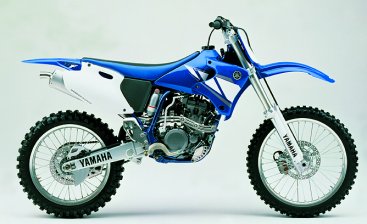
Who will like this bike? This is the most interesting question, with the most interesting answer. As far as we can tell, everyone will like this bike. Open class riders and 125cc pilots will all enjoy riding the YZ250F. There is a good chance their lap times would drop, as well, and they would certainly be riding faster and stronger at the end of a moto than they would be on most other machines. Pros may want more power (a 250 two-stroke or open four-stroke).
The YZ250F makes a reasonably good trail bike, as well. The torque and broad, smooth power (that hits much more softly than an open class four-stroke) work well off-road, although here we would almost certainly opt for a wider, 18-inch rear tire.
The transmission ratios are reasonably good for motocross. Probably better for tight tracks, as the machine does not have an extremely high top speed. The transmission available on the WR250F would be a better choice for many riders who will use their bike for trails, enduros or desert riding.
We still don’t know how Yamaha decided, far earlier than its Japanese competition, to move in the direction of high-performance, light weight, four-stroke motocross and enduro bikes. We’re just glad they did.





